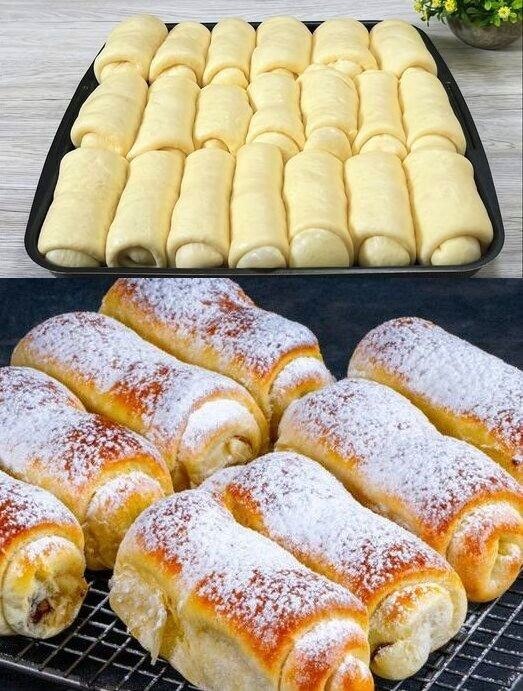ADVERTISEMENT
### **The History of Grandma’s Rolls**
To truly appreciate **Grandma’s Rolls**, it’s important to understand the rich history behind them. This recipe, handed down through generations, was likely passed from one grandmother to the next, refined over decades, and shared in homes as a cherished family tradition.
The origins of this particular roll recipe are difficult to trace precisely, but it is likely based on old-fashioned yeast rolls, a staple in many households dating back to the late 19th and early 20th centuries. Before the advent of mass-produced bread, many families relied on homemade bread and rolls for daily meals. Yeast rolls were particularly favored because of their light, airy texture, which made them perfect for soaking up gravies, sauces, and soups.
Grandma’s version of the recipe, however, might have come with its own secret ingredient or method, handed down with a special touch only the family matriarch knew how to master. These rolls became a symbol of home-cooked love — a tradition that united families around the dinner table for holidays, special occasions, or any meal where a little extra comfort was needed.
Though bread-making technology has certainly advanced over the years, there’s something magical about using a 100-year-old recipe. It’s like baking a little bit of history into every batch, capturing the essence of simpler times while still delighting the modern palate.
—
### **Why Are Grandma’s Rolls So Special?**
**Grandma’s Rolls** are revered for their super soft texture, which can be attributed to a combination of ingredients and methods that create a melt-in-your-mouth experience. They have a slightly sweet flavor and a tender crumb, perfect for slathering with butter, jam, or even dipping into your favorite soup.
What makes them so special is the careful balance of a few key factors:
1. **The Yeast**: Yeast is what gives these rolls their lightness and fluffiness. The yeast needs time to rise and create air pockets in the dough. This process is what results in those soft, pillowy rolls that you love. Unlike quick breads or baking powder biscuits, yeast rolls require a slower, more methodical approach.
2. **The Kneading**: Kneading the dough for an adequate amount of time is crucial for developing the gluten structure in the dough. This step ensures that the rolls maintain their soft texture while providing just the right amount of elasticity.
3. **The Resting Time**: Allowing the dough to rest and rise properly is an important step in the process. The longer the dough has to rise, the more flavor develops. This resting time is what gives these rolls their subtle sweetness and depth of flavor.
4. **Butter**: Butter contributes richness and tenderness to the rolls. It’s also one of the reasons they are so irresistibly soft. Grandma’s secret to extra soft rolls is likely in the generous amount of butter that’s incorporated into the dough.
5. **The Love and Tradition**: Every family recipe has its own unique energy, and **Grandma’s Rolls** are no exception. The tradition of making these rolls and passing them down through the generations adds a personal touch that elevates the experience. It’s not just about the ingredients or the method — it’s about sharing something made with care and love.
—
### **Ingredients for Grandma’s Rolls**
Before you begin making **Grandma’s Rolls**, let’s go over the ingredients you’ll need. These ingredients are simple, but they work together to create a soft and delicious roll that is sure to become a family favorite:
#### **For the Rolls:**
– **4 cups all-purpose flour**: The base of your dough. You’ll need just the right amount of flour to achieve a soft, tender texture.
– **1 packet active dry yeast (about 2 1/4 teaspoons)**: Yeast is the magic that makes the rolls rise and gives them that fluffy, light texture.
– **1/4 cup granulated sugar**: Sugar helps feed the yeast and gives the rolls a slight sweetness, which is characteristic of this recipe.
– **1 teaspoon salt**: Salt enhances the flavor and balances the sweetness of the sugar.
– **1/2 cup warm milk**: The milk will help activate the yeast and make the dough soft. Be sure the milk is warm, but not too hot — about 110°F (43°C) is perfect.
– **1/4 cup warm water**: Used to help activate the yeast. The combination of warm water and milk provides the ideal environment for the yeast to bloom.
– **1/4 cup unsalted butter**: Butter is key to achieving the soft, rich texture that makes these rolls so indulgent.
– **1 large egg**: The egg helps with binding the ingredients together and adds richness to the dough.
– **1/4 cup vegetable oil**: Oil adds moisture to the dough and helps with tenderness.
– **Additional butter for brushing**: After baking, brushing the rolls with melted butter adds extra flavor and a soft sheen to the surface of the rolls.
For Complete Cooking STEPS Please Head On Over To Next Page Or Open button (>) and don’t forget to SHARE with your Facebook friends
